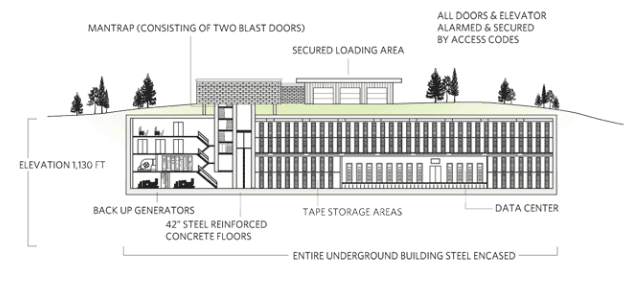 I recently had the opportunity to visit a very unique data tape vault run by Vital Records, Inc. The location I visited is in Roxbury New Jersey, about an hour drive from New York City. What makes this tape vault known as VRI
I recently had the opportunity to visit a very unique data tape vault run by Vital Records, Inc. The location I visited is in Roxbury New Jersey, about an hour drive from New York City. What makes this tape vault known as VRI Roxbury, so unique is that it is 125,000 square feet of vault space situated between 30 and 50 feet underground. It was originally built by AT&T as a hardened command center bunker in the 1960’s. The facility is an intriguing blast from the past with relics of AT&T’s occupancy tastefully preserved. It was built to withstand natural disasters such as hurricanes, tornadoes, floods, wildfires or dare I say, a nearby nuclear blast. In such an event, AT&T could continue to support the telecommunications needs of its clients, including the U.S. Military. So no expense was spared in building what is truly an engineering marvel below ground.
Roxbury, so unique is that it is 125,000 square feet of vault space situated between 30 and 50 feet underground. It was originally built by AT&T as a hardened command center bunker in the 1960’s. The facility is an intriguing blast from the past with relics of AT&T’s occupancy tastefully preserved. It was built to withstand natural disasters such as hurricanes, tornadoes, floods, wildfires or dare I say, a nearby nuclear blast. In such an event, AT&T could continue to support the telecommunications needs of its clients, including the U.S. Military. So no expense was spared in building what is truly an engineering marvel below ground.
Vital Records purchased the facility in 1995 upon its decommissioning by AT&T and repurposed the space for protection and preservation of valuable enterprise data, most often in the form of millions of removable/portable data and video tapes. To say that the facility is fascinating would be an understatement. It is however, non-descript, at least upon arrival. VRI Roxbury is discreetly perched in the middle of desolate woods, atop a slight rise in the landscape, some 1,100+ feet above sea level, with nothing but a nameless security gate, a freshly painted parking lot, and a small anonymous structure housing an elevator entrance to accommodate pre-screened visitors and authorized employees at any time of day, 24/7.
 Truth be told, this was not my first visit to VRI Roxbury. I had toured the facility some 20 years earlier while working for another data tape manufacturer. And while the facility has kept up with modern innovations such as security protocols including iris scans, temperature and humidity monitoring, hi-def video surveillance, new and improved inventory management techniques, it still essentially provides the same services today that it did 20 years ago. However, given several critical market dynamics, these services are more relevant today than ever before.
Truth be told, this was not my first visit to VRI Roxbury. I had toured the facility some 20 years earlier while working for another data tape manufacturer. And while the facility has kept up with modern innovations such as security protocols including iris scans, temperature and humidity monitoring, hi-def video surveillance, new and improved inventory management techniques, it still essentially provides the same services today that it did 20 years ago. However, given several critical market dynamics, these services are more relevant today than ever before.
So here are my top five reasons why data tape vaults are not going away, and in fact, thriving today.
 consumption, global warming, climate change and therefore, carbon footprint. 20 years ago, this was a non-issue. Really big SUVs ruled the highways and when more data storage was needed, an energy intensive disk array could simply be added without any thought. Today, we as a global society are scrambling to reduce carbon footprint and the associated negative impacts of climate change from extreme weather that has resulted in catastrophic events from floods to forest fires. When it comes to data storage, it’s helpful to simply move cold and inactive data from energy intensive 24/7 spinning disk to eco-friendly data tapes. Tapes consume no energy unless actively engaged in a tape drive, reducing energy consumption by 87% and reducing CO2e by 97% over the product lifecycle. Since 60 to 80% of data quickly goes cold after just 90 to 120 days, moving that data from energy intensive primary storage to automated tape systems with the option for an offsite, offline copy is quickly becoming an imperative for Chief Sustainability Officers who want to make a difference.
consumption, global warming, climate change and therefore, carbon footprint. 20 years ago, this was a non-issue. Really big SUVs ruled the highways and when more data storage was needed, an energy intensive disk array could simply be added without any thought. Today, we as a global society are scrambling to reduce carbon footprint and the associated negative impacts of climate change from extreme weather that has resulted in catastrophic events from floods to forest fires. When it comes to data storage, it’s helpful to simply move cold and inactive data from energy intensive 24/7 spinning disk to eco-friendly data tapes. Tapes consume no energy unless actively engaged in a tape drive, reducing energy consumption by 87% and reducing CO2e by 97% over the product lifecycle. Since 60 to 80% of data quickly goes cold after just 90 to 120 days, moving that data from energy intensive primary storage to automated tape systems with the option for an offsite, offline copy is quickly becoming an imperative for Chief Sustainability Officers who want to make a difference. hybrid magnetic particles such as Barium Ferrite, Strontium Ferrite and in the future, Epsilon Ferrite. All with the ability to improve data density and archival life. Today’s highly advanced and modern tapes have outpaced HDDs with higher capacities, better reliability, longer life, lower cost, lower CO2e footprint and can be efficiently transported offsite for data protection including cybercrime protection and long term data retention. Current tape technology roadmaps provide the ability to plan data migrations for many decades yet to come.
hybrid magnetic particles such as Barium Ferrite, Strontium Ferrite and in the future, Epsilon Ferrite. All with the ability to improve data density and archival life. Today’s highly advanced and modern tapes have outpaced HDDs with higher capacities, better reliability, longer life, lower cost, lower CO2e footprint and can be efficiently transported offsite for data protection including cybercrime protection and long term data retention. Current tape technology roadmaps provide the ability to plan data migrations for many decades yet to come.So while walking into the VRI Roxbury underground tape vault is a bit of a blast from the past, it’s also a glimpse into the decades ahead where tried and true technologies and best practices are the lock and key to successful data storage protection and retention.
